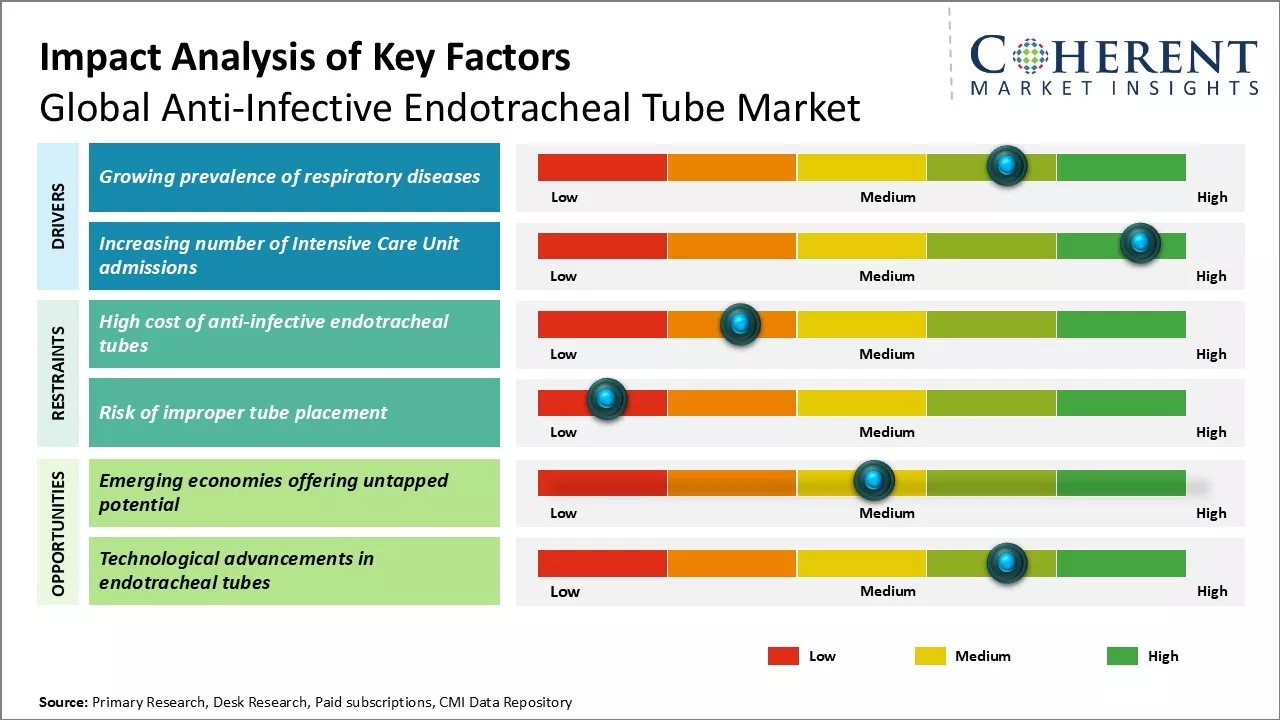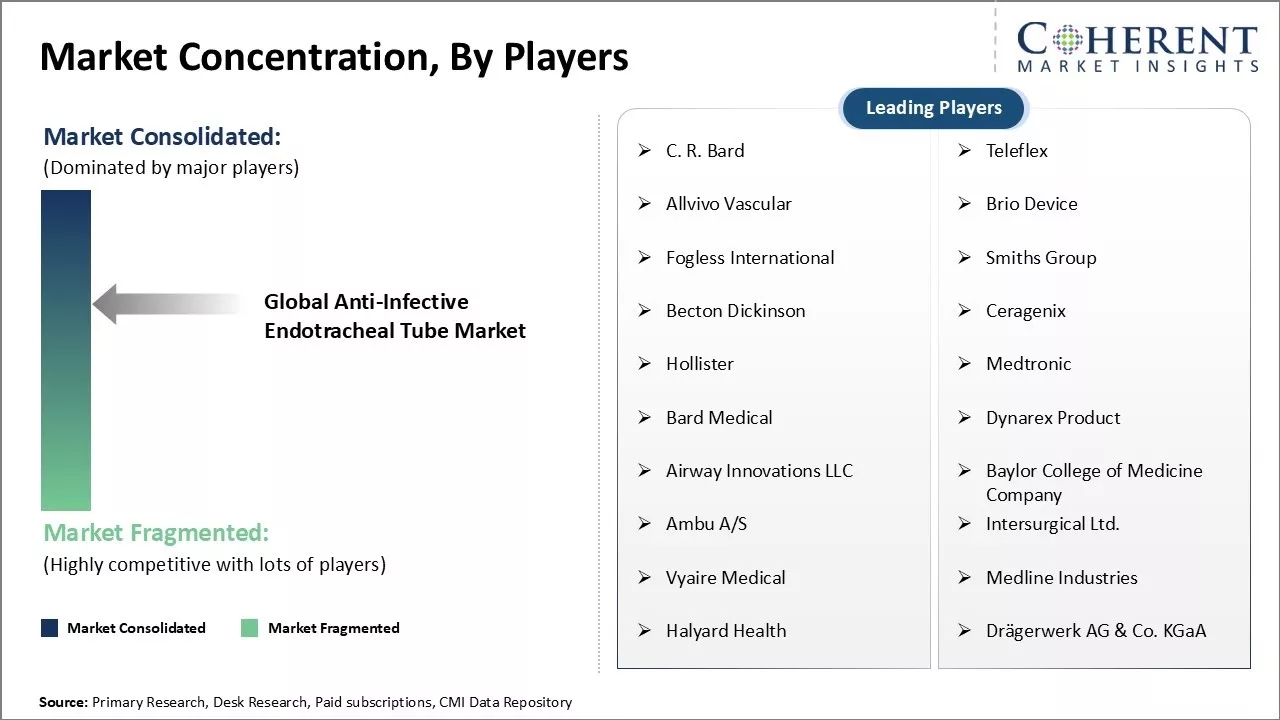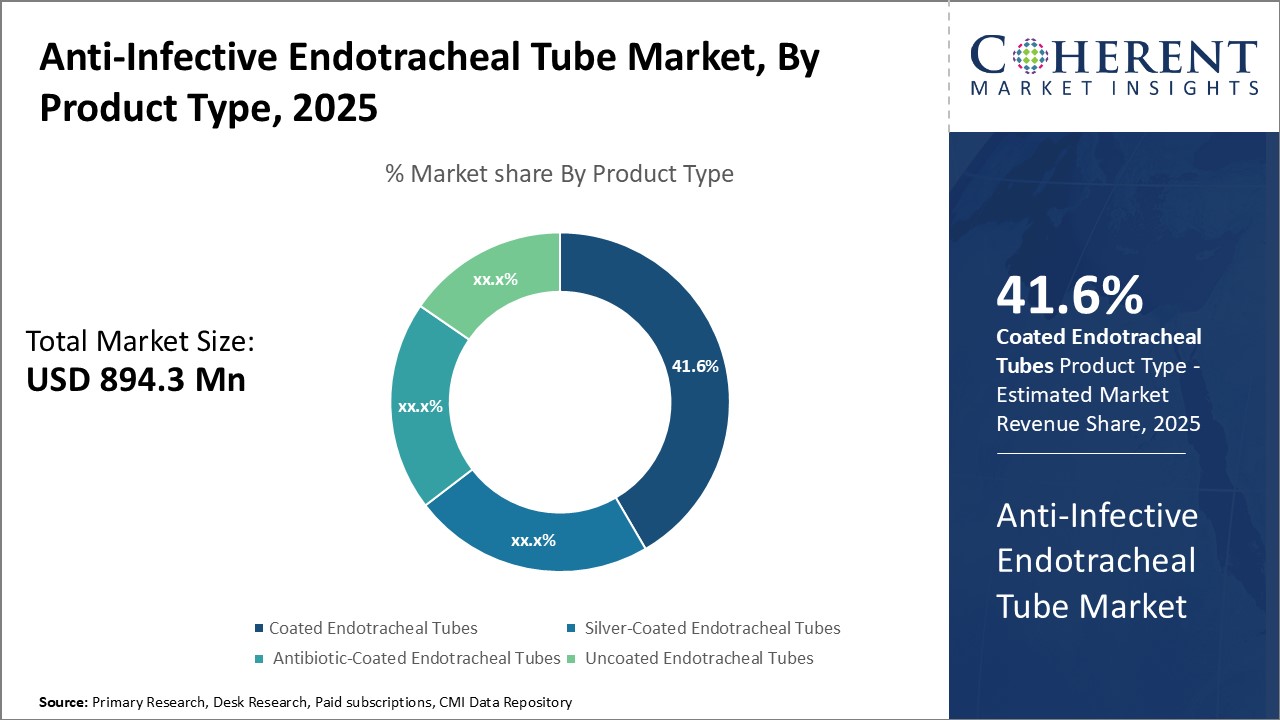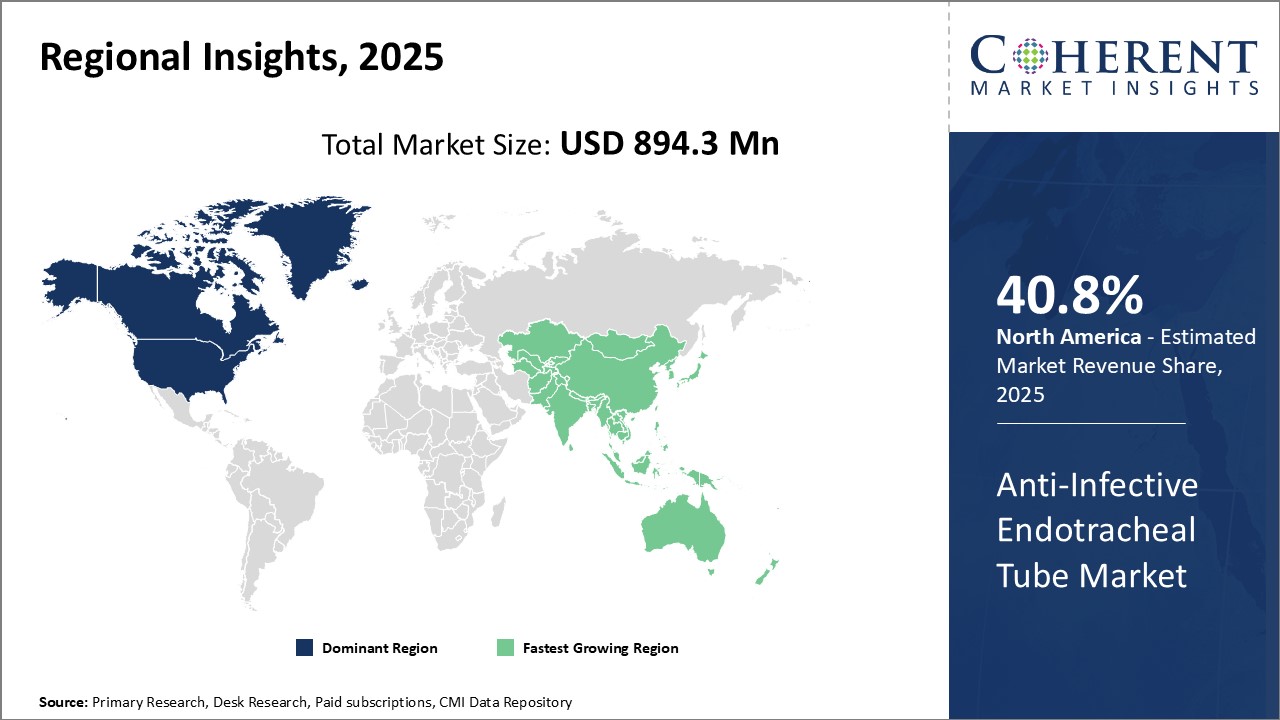Anti-Infective Endotracheal Tube Market Size and Trends
Global anti-infective endotracheal tube market is estimated to be valued at USD 894.3 Mn in 2025 and is expected to reach USD 1,276.1 Mn by 2032, exhibiting a compound annual growth rate (CAGR) of 5% from 2025 to 2032.

Discover market dynamics shaping the industry: Download Free Sample
Increasing incidence of hospital-associated infections and rising demand for advanced medical devices to curb the risk of infection can drive the market growth. Rising number of surgical procedures performed worldwide and growing geriatric population who are prone to chronic diseases and requires ventilation support can also boost the usage of anti-infective endotracheal tubes. However, availability of alternative intubation and ventilation methods and lack of awareness regarding benefits of anti-infective endotracheal tubes in developing countries can hamper the market growth over the forecast period.
Market Driver - Growing prevalence of respiratory diseases
With changing lifestyle and rising pollution levels, there has been increase in incidence of respiratory diseases globally. Chronic respiratory conditions like asthma and COPD have become quite common, owing to rising air pollution and tobacco consumption. According to some estimates, over 235 million people suffer from asthma and prevalence has increased by over 50% in the last 25 years. These chronic respiratory diseases often require hospitalization when condition deteriorates and exacerbate.
Seasonal infections like pneumonia and influenza continue to plague people of all age groups but has higher impact on aged population and children. Such lower respiratory tract infections can sometimes turn critical, requiring mechanical ventilation support through endotracheal intubation. According to WHO, lower respiratory infections are one of the top five causes of deaths worldwide. These can lead to acute respiratory failure needing respiratory support through artificial airways like endotracheal tubes in some severe cases.
With growing global pollution levels due to rapid urbanization and industrialization, there has been increase in cases of respiratory diseases, thus, imposing greater disease burden. This can boost demand for respiratory support equipment including anti-infective endotracheal tubes, which can help lower the risks of ventilator-associated pneumonia. The tube is inserted with an inflated cuff that reduces leakage of oral and gastric secretions into the lungs to minimally support hospital-acquired infections in critically ill patients. Thus, surging prevalence of chronic and acute respiratory infections boosts need for effective ventilation strategies and drive the anti-infective endotracheal tube market growth.For Instance, According to article published in The Indian Express [P] Ltd. A recent study conducted by MSRC & Group, a healthcare research and consulting organization, has revealed that Chronic Obstructive Pulmonary Disease (COPD) is one of the fastest-growing respiratory diseases in India. The study, based on a 15-year prescription audit involving over 10,700 doctors across 80 cities and towns, found that respiratory diseases now represent the largest disease area in the country, accounting for 15.3% of all prescriptions.
Market Concentration and Competitive Landscape

Get actionable strategies to beat competition: Download Free Sample
Increasing number of intensive care unit admissions
Rise in population vulnerability to health deteriorations, availability of improved critical care facilities and aging populations contribute to increasing ICU admissions in hospitals worldwide. ICUs commonly treat patients suffering major trauma injuries, undergoing complex surgeries or battling life-threatening illnesses. Vast majority of patients in ICUs require ventilation support due to respiratory failure, which involves endotracheal intubation. As per some estimates, over 4 million patients are admitted to ICUs annually in the United States. With improving access to healthcare services in developing nations, the global ICU caseload has seen consistent expansion over the past decade.
Prolonged ventilation further increases the threat of hospital-acquired lung infections like ventilator-associated pneumonia. It is one of the most prevalent healthcare-associated infections accounting for over 25% of total HAI burden. Around 10% of all hospitalized patients get into the ICU at some point, thus, it is important to reduce infection rates. Hence, hospitals are increasingly employing anti-infective endotracheal tubes as these significantly reduce VAP occurrence and help ICUs adhere to stringent patient safety and hygiene guidelines.
Key Takeaways from Analyst:
Global anti-infective endotracheal tube market growth is driven by rising prevalence of hospital-acquired pneumonia that boosts demand for anti-infective endotracheal tubes. These tubes help prevent infection transmission through the breathing circuit in ventilated patients. North America currently dominates the market, owing to increasing ICU admissions and the presence of advanced healthcare facilities. However, Asia Pacific is expected to witness the fastest growth, owing to growing medical tourism and rising healthcare expenditure in the region.
Stringent regulatory approvals pose a major challenge to new market entrants. Product recalls due to quality issues can hamper the market growth. Inadequate reimbursement policies in developing nations can also hamper the market growth. Increasing incidence of chronic respiratory diseases and growing popularity of single-use endotracheal tubes can offer numerous opportunities for manufacturers. Furthermore, rising penetration in untapped developing markets of Latin America and the Middle East can provide lucrative prospects over the forecast period. Technology advancements leading to enhanced safety and efficiency of these tubes can also drive the market growth.
Market Challenge - High cost of anti-infective endotracheal tubes
Global anti-infective endotracheal tube market growth can be hampered due to high cost associated with these medical devices. Anti-infective endotracheal tubes are engineered to prevent hospital-acquired infections through various mechanisms like impregnating with antimicrobial agents. However, this additional safety feature are expensive as compared to conventional endotracheal tubes. Healthcare systems across major markets have constrained budgets for medical devices and equipment. Premium pricing of anti-infective versions poses affordability issues, restricting their widespread adoption. Manufacturers also attempt to recover their investments in R&D and clinical trials through product pricing. This makes anti-infective endotracheal tubes costly choices for patients in developing nations and underserved regions where incidences of infections are higher. Price sensitivity can also hamper the market growth unless costs are lowered through improved production techniques and scale economies.
Market Opportunity - Emerging economies offering untapped potential for market
Global anti-infective endotracheal tube market can witness new growth opportunities emerging from developing and underpenetrated markets. Rapid economic development and rising disposable incomes enable greater government and individual spending on healthcare advances in nations like India, Brazil, Indonesia and African countries. As per capita medical expenditure increases, these emerging patient pools will look for superior safety measures and premium products to tackle preventable hospital infections. Since infection rates are higher in developing Asian and Latin American countries due to limited hygiene and sanitation, there will be huge demand for anti-infective endotracheal tubes. Growing medical tourism and rising medical standards in smaller cities and towns within emerging markets can boost sales volumes. If manufacturers cater innovative and affordable product offerings, significant untapped revenues can be tapped from these developing regions in the near future.

Discover high revenue pocket segments and roadmap to it: Download Free Sample
By Product Type - Increasing preference for safety and infection control boosts adoption of coated endotracheal tubes
In terms of product type, coated endotracheal tubes segment is estimated to contribute the highest market share of 41.6% in 2025, owing to increasing demand for safety and infection control measures in healthcare settings. Coated endotracheal tubes provide crucial protection to patients against various healthcare-associated infections during intubation procedures and mechanical ventilation. Their hydrophilic, antimicrobial coatings prevent bacterial adhesion and biofilm formation inside the endotracheal tube, thus, lowering infection risks. Furthermore, coated tubes facilitate easy endotracheal suctioning and secretions management. These reduce inflammation in the trachea and larynx as compared to uncoated tubes. Hospitals and ICUs extensively utilize coated endotracheal tubes as these offer enhanced protection to critically-ill patients who are highly susceptible to respiratory infections. Growing emphasis on safety, hygiene and high-quality care boosts the uptake of coated tubes over conventional types.
By Material - Material compatibility boosts adoption of polyvinyl chloride
In terms of material, polyvinyl chloride (PVC) segment is estimated to contribute the highest market share of 38.5% in 2025, owing to its excellent material properties and compatibility. Being non-toxic and non-allergenic in nature, PVC shows high biocompatibility with human tissues. It does not leach out any harmful chemicals or plasticizers inside the body. PVC tubes are flexible yet durable for withstanding prolonged intubation procedures without becoming brittle. These maintain their shape and do not undergo dimensional changes with use. Moreover, PVC is cost-effective compared to other materials like silicone and polyurethane. It can be easily processed into tubes of customizable diameters using extrusion technology. Due to good material characteristics, PVC endotracheal tubes are appropriately compatible for serving diverse patient demographics and clinical needs.
By End User - Expanding patient pool drives hospitals segment
In terms of end user, hospitals segment is estimated to contribute the highest market share of 42.8%, owing to presence of large patient pool. Hospitals cater to diverse medical emergencies and accommodate significant number of critically-ill patients requiring intensive respiratory support and ventilation. The hospital settings have complicated patient cases involving multiple co-morbidities that often lead to acute respiratory distress and failure. This boosts demand for endotracheal intubation procedures within hospitals on a daily basis. Moreover, hospitals are well-equipped with advanced ICUs, emergency departments, and operating rooms that conduct high volume of surgical interventions and emergency resuscitations where endotracheal intubation is an indispensable part of medical management. Growing disease prevalence, rising number of surgeries, increasing healthcare investments, and infrastructure development in hospitals can boost demand for anti-infective endotracheal tubes.
Regional Insights

Need a Different Region or Segment? Download Free Sample
North America dominates the global anti-infective endotracheal tube market with an estimated market share of 40.8% in 2025, owing to highly developed healthcare system and greater awareness among healthcare providers about hospital-acquired infections. Leading medical device companies in the region are continuously investing in new product launches.
Asia Pacific has emerged as the fastest growing regional market, due to rising healthcare expenditure, growing population, increasing number of hospitals, and surgical procedures in countries like China and India. Rising awareness among medical practitioners about the need to reduce infections acquired in intensive care units where endotracheal tubes are extensively used can also drive the market growth in Asia Pacific.
Several medical device companies from other mature markets are focusing on establishing manufacturing facilities in Asia to cater to growing demand. This improves the availability of technologically advanced products in the region. While North America market benefits from well-established distribution channels of major players, market participants in Asia Pacific are focusing on expanding their distribution footprint to explore growth opportunities.
There has been rising exports of anti-infective endotracheal tubes from mature markets like the U.S. and Western European countries to countries in Latin America, Middle East and Africa.
Market Report Scope
Anti-Infective Endotracheal Tube MarketReport Coverage
| Report Coverage | Details | ||
|---|---|---|---|
| Base Year: | 2024 | Market Size in 2025: | USD 894.3 Mn |
| Historical Data for: | 2020 To 2024 | Forecast Period: | 2025 To 2032 |
| Forecast Period 2025 to 2032 CAGR: | 5.2% | 2032 Value Projection: | USD 1,276.1 Mn |
| Geographies covered: |
|
||
| Segments covered: |
|
||
| Companies covered: |
C. R. Bard, Teleflex, Allvivo Vascular, Brio Device, Fogless International, Smiths Group, Becton Dickinson, Ceragenix, Hollister, Medtronic, Bard Medical, Dynarex Product, Airway Innovations LLC, Baylor College of Medicine Company, Ambu A/S, Intersurgical Ltd., Vyaire Medical, Medline Industries, Halyard Health, Drägerwerk AG & Co. KGaA |
||
| Growth Drivers: |
|
||
| Restraints & Challenges: |
|
||
Uncover macros and micros vetted on 75+ parameters: Get instant access to report
Anti-Infective Endotracheal Tube Industry News
- In June 2023, Teleflex Incorporated, a prominent global provider of medical technologies that specializes in critical care and surgical procedures, issued a worldwide recall of specific batches of Rüsch Endotracheal Tube products. These devices are designed for oral or nasal intubation, facilitating airway management by inserting the tube into the patient's trachea through the nose or mouth. Stylets are used to assist in the placement of these endotracheal tubes into the trachea.
- In August 2021, Researchers at Children's Hospital of Philadelphia (CHOP) developed a coating for endotracheal tubes that releases antimicrobial peptides targeting specific bacteria. In a proof-of-concept study, the coating demonstrated consistent peptide release over two weeks, potentially reducing bacterial inflammation and preventing subglottic stenosis during intubation.
- In May 2021, Medtronic launched the SonarMed airway monitoring system in the U.S., the first device using acoustic technology to detect endotracheal tube (ETT) obstructions and verify its position in real-time. This system provides critical information to help clinicians make informed, life-saving decisions for their smallest patients.
*Definition: Global anti-infective endotracheal tube market consists of tubes integrated with anti-infective agents that are inserted through the mouth into the trachea (windpipe) to maintain an open airway and allow ventilation during medical procedures requiring mechanical ventilation or anesthesia.
Market Segmentation
- Product Type Insights (Revenue, USD Mn, 2020 - 2032)
-
- Coated Endotracheal Tubes
- Silver-Coated Endotracheal Tubes
- Antibiotic-Coated Endotracheal Tubes
- Uncoated Endotracheal Tubes
- Material Insights (Revenue, USD Mn, 2020 - 2032)
-
- Polyvinyl Chloride (PVC)
- Silicone
- Polyurethane
- Others (Rubber, Nylon, etc.)
- End User Insights (Revenue, USD Mn, 2020 - 2032)
-
- Hospitals
- Intensive Care Units (ICUs)
- Emergency Departments
- Ambulatory Surgical Centers
- Other Healthcare Settings
- By Regional Insights (Revenue, USD Mn 2020 - 2032)
-
- North America
- U.S.
- Canada
- Latin America
- Brazil
- Argentina
- Mexico
- Rest of Latin America
- Europe
- Germany
- U.K.
- Spain
- France
- Italy
- Russia
- Rest of Europe
- Asia Pacific
- China
- India
- Japan
- Australia
- South Korea
- ASEAN
- Rest of Asia Pacific
- Middle East
- GCC Countries
- Israel
- Rest of Middle East
- Africa
- South Africa
- North Africa
- Central Africa
- North America
- Key Players Insights
- C.R. Bard
- Teleflex
- Allvivo Vascular
- Brio Device
- Fogless International
- Smiths Group
- Becton Dickinson
- Ceragenix
- Hollister
- Medtronic
- Bard Medical
- Dynarex Product
- Airway Innovations LLC
- Baylor College of Medicine Company
- Ambu A/S
- Intersurgical Ltd.
- Vyaire Medical
- Medline Industries
- Halyard Health
- Drägerwerk AG & Co. KGaA
Share
Share
About Author
Manisha Vibhute is a consultant with over 5 years of experience in market research and consulting. With a strong understanding of market dynamics, Manisha assists clients in developing effective market access strategies. She helps medical device companies navigate pricing, reimbursement, and regulatory pathways to ensure successful product launches.
Missing comfort of reading report in your local language? Find your preferred language :
Transform your Strategy with Exclusive Trending Reports :
Frequently Asked Questions
EXISTING CLIENTELE
Joining thousands of companies around the world committed to making the Excellent Business Solutions.
View All Our Clients
